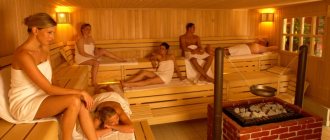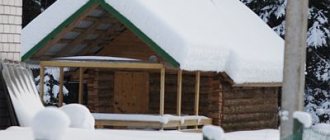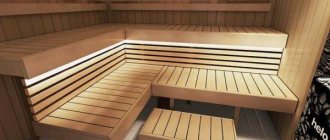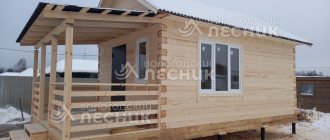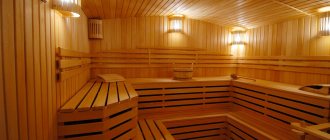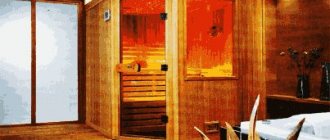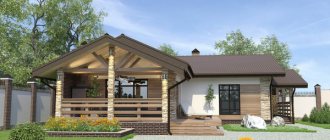In order to maintain a comfortable temperature in the main rooms of the bathhouse and ensure hot water supply, it is important to properly organize heating in the bathhouse from a heater located in the steam room, or use alternative sources. At the same time, each bathhouse owner can create an autonomous heating system independently, without involving outside help.
Need for additional heating
The classic option for heating a steam room for bathing procedures is a brick or metal heater. In this case, additional equipment is used to maintain a given air heating temperature both in the steam room and in other rooms.
It is impossible to ensure fast and uniform heating of the dressing room and rest room from a sauna stove.
And if in summer this does not cause problems, then in winter such a situation can lead to a decrease in comfort when organizing a bathing holiday. In this case, all the heat produced will be accumulated in the steam room, and the dressing room and other rooms of the bath will remain unheated.
Installation of additional heating equipment will ensure the maintenance of a comfortable temperature necessary for a long stay in the dressing room.
Drying the bath
There are two components to quickly drying wet rooms: heating and ventilation. They should not be considered separately, because together they work most effectively. You just need to combine them in a specific case.
How to dry: ventilation methods
The ventilation system is laid at the stage of construction of the bathhouse (see here about the diagrams and design of the bathhouse ventilation). Therefore, if something is forgotten, it may be too late to redo everything.
vents are usually made in the foundation - these are through holes lined with sewer (most often) pipes that lead to the underground space. They have plugs on the outside that allow you to open and close them at the right time.
More details about the scheme can be found here
Such vents are opened only after procedures. And they serve for better ventilation and drying of the bath.
Also, another through hole is usually made in the wall of the steam room under the shelves On the inside it has an adjustable plug. This hole is also used to speed up the drying of the steam room.
You can dry the bathhouse in winter with the help of ventilation by opening and doors wide - after all, the air inside is much more saturated with water vapor. But you shouldn’t think that all the moisture will leave the bathhouse only thanks to open doors and windows.
In addition to ways to create a draft simply by opening holes, there is another method where ventilation actively cooperates with heating and works when the stove is on - this is bastu, which you can read about here.
Well, don’t forget that even if natural ventilation is not installed correctly or its power is not enough to ventilate the bathhouse, you can always install fans in the air ducts . Forced ventilation, although noisy, is still effective.
BY THE WAY! Heat guns can help here too.
For those who believe that heating alone is enough, and ventilation becomes optional, we recommend watching the video by Konstantin Bely:
Heating by stove-stove
For small baths, a traditional heater remains a viable heating option. In this case, it is enough to purchase or manufacture a heating unit of the required power.
Calculation of equipment power is determined by the formula: 1 kW of power per 1 sq. m of premises. To ensure a comfortable stay for visitors in the steam room, a thermal power reserve of 35 to 55% is additionally taken into account.
The popularity of the heating heater is explained by the following advantages:
- ease of installation and maintenance;
- accessibility of operation;
- using available fuel.
When giving preference to a sauna stove, do not forget about some of the disadvantages of the device:
- impressive dimensions and weight;
- inability to automate the process of heating rooms;
- high fire hazard;
- formation of fuel combustion products.
Modern heaters operate on wood, electricity, liquid and gaseous fuel. The choice of the appropriate option depends on the financial capabilities and technical capabilities of the equipment.
To ensure effective heating of the room, heating the bath from the stove in the steam room is done as follows: the firebox is placed in the dressing room, the heater is in the steam room, and the tank with warm water is in the washing compartment.
How to choose
Before choosing a device for heating a summer house in winter, you need to consider several types of such devices and determine which one is suitable for a particular home. There are many models that will provide your home with hot water.
Most sauna heaters are powered by electricity. They are purchased quite often, which is due to the ease of use of the device. Increasingly, owners of suburban areas are purchasing infrared heaters. To decide to purchase such a device, it is necessary to consider the advantages and disadvantages of these designs.
Heating by furnaces with heat exchangers
Stoves with heat exchangers are an alternative option to conventional heaters, which provide space heating, hot water supply and steam generation.
Heating in a bathhouse from a stove heat exchanger can be organized both for the main premises - steam room and washing room, and for auxiliary ones - dressing room, relaxation room, billiard room, shower room, swimming pool.
At the design stage of heating equipment with a heat exchanger, the following data is taken into account:
- dimensions of the building and area of premises;
- design features of the furnace;
- weight of heating equipment;
- number of heat exchangers;
- coolant volume;
- length and diameter of the chimney pipe.
The following options for connecting heating equipment using pipes are possible:
- to the expansion tank for hot water supply in the washing compartment;
- to heating radiators installed in functional rooms;
- to hot water supply and water heating system in the main premises of the bathhouse and residential building.
Heating stoves are equipped with internal and external heat exchangers. The internal element is located in the firebox, the external element is located around the chimney pipe.
Don't forget about safety
But it is not advisable to install electric heated floors in the steam room itself. Yes, this will make going to the bathhouse more comfortable. After all, true connoisseurs of baths know that it is the floors, especially in winter, that can remain cool even after heating for many hours. All the heat rises, and near the ceiling the temperature can reach 70-80 degrees, but the floors will remain cool. This definitely won’t happen when using electric heated floors - they will heat up much faster than the bathhouse will heat up.
Electric heating system
Electric heating is the simplest and most affordable option for organizing an autonomous bath heating system. When organizing it, it is worth taking into account the electrical wiring diagram, the total load on the network and the cross-section of the wires in order to carry out high-quality installation work.
The electric heating system involves the use of the following types of equipment:
- electric boiler;
- electric stove;
- electric convectors;
- infrared film;
- electric heating cables.
Modern low-power electric boilers are equipped with automation that can maintain a given temperature in bath rooms. To heat the bath, it is allowed to use induction, electrode and stepped boilers with heating elements.
An electric heater for a bath can be used as a main and additional source of heating. If possible, it is most convenient to use electric convectors. As with boilers, convectors are equipped with thermostats to maintain the optimal temperature automatically.
The electrical system can be operated year-round without the need for preparation and storage of fuel material. A significant drawback is the high electricity consumption.
What equipment is required for this?
In general, to ensure heating of the bath in winter, you can use a variety of equipment. Some users prefer water heating. Radiators or water heated floors can be connected to a heating plant or a heating system from the house. However, there is a certain disadvantage here. If you do not live in a country house permanently, the water in the pipes will simply freeze, bursting them, since the heating plant may stop working for several days for some reason. As a result, you will have to spend a lot of money and time to eliminate the consequences of such a breakdown.
Stove in a bathhouse with a water heater
Many people prefer electric heating devices. Their main advantage is ease of use. There is no need to spend money on installation or disassemble a ready-made bathhouse. You can bring one or two electric heaters into the dressing room at any time and turn them on half an hour to an hour before the start of the gatherings.
But there is a certain disadvantage here too. Most often, the humidity in the dressing room is quite high, especially if it is located across the wall from the steam room, and the door regularly opens and closes. Electrical appliances do not work well in conditions of high humidity - there is a high probability of breakdown. And being left without a heater before meeting friends on cold winter days is not a very pleasant surprise.
Electric heater for a bath
Therefore, electric heated floors remain one of the best solutions. Yes, you will have to spend a fairly large sum during installation - such work should only be performed by specialists if you do not have the appropriate skills. But in this case, you don’t have to worry about breakdowns or any other unpleasant consequences.
Electrical cables are reliably protected from moisture, which means they will not suffer even when working in difficult conditions. They are also not afraid of temperature changes. Even if you leave the dacha for several weeks or months, it is enough to turn off the heated floors - nothing will harm them. But when you get ready to go to the bathhouse, 3-4 hours before the water procedures it is enough to turn on the heating system. During this time, the temperature in the dressing room will rise to a level at which you and your guests will feel comfortable even after a hot steam room.
Heated floor diagram
The possibilities of electric heated floors are not limited to this. Some bathhouse owners decide to install a heating system, both in the bathhouse itself and outside it. First of all, this is the porch. Many bathhouse connoisseurs are familiar with the problem of porch icing. Water may be accidentally spilled there if you carry it to the bathhouse by hand.
But this can be avoided if, when installing a heated floor system, you order two circuits: one, large, for heating the dressing room, and the second, small, for heating the porch. In this case, the water will never freeze on the porch, but will drain from it or gradually evaporate. Be that as it may, the ice problem will be solved.
Gas heating system
When connected to a gas main, heating a bathhouse with gas is the fastest and most efficient option for the system.
The system has two implementation options:
- traditional heater equipped with a gas burner;
- gas boiler with installation of heating radiators and water pipes.
The undoubted advantage of such heating is the absence of unpleasant odors, the formation of soot and soot. At the same time, gas equipment has a compact body, low weight and does not require much space during installation. The power of a standard boiler reaches 45 kW, which is enough to heat a room up to 280 square meters. m.
Construction of a brick stove
The main problem that arises when installing a brick heater is the massiveness of the structure. This requires the construction of a reinforced concrete foundation. For those who do not have experience in building sauna stoves with their own hands, the following tips may be useful.
If you put a thick layer of mortar between the brick joints, then under the influence of high temperatures it will begin to collapse and the heater will become leaky. On the contrary, a thin layer of mortar between the brick joints will negatively affect the life of the structure.
Each vertical layer of masonry must be covered with a top brick. It is advisable to make the ceilings in half a brick.
https://youtube.com/watch?v=cJLIxnSHc68
There are other nuances. So, if cut bricks are used, then the whole side should be turned inside the furnace. To ensure uniform linear expansion, cast iron elements are installed with a gap. To secure the upper part of the stove door, it is better to use a metal clamp.
Water heating system
A practical and affordable way to organize heating of a bathhouse in winter is to install a water system.
Water is used as a coolant, gas, electricity, liquid and solid fuel are used as fuel, and a stove or boiler is used as heating equipment.
Water heating provides quick and uniform heating of bath rooms with the ability to automatically maintain the set temperature.
There are the following options for arranging water heating:
- Radiator heating. Provides for laying pipes along the walls to which water radiators or convectors of the appropriate size and power are connected. The hot coolant from the boiler moves inside the system, providing space heating.
- Underfloor heating. Its operating principle is similar to that in the previous version. The only difference is that the installation of pipes is carried out in a concrete base after its preliminary insulation and waterproofing. This design is of a non-removable type, and therefore requires compliance with installation technology.
Pellet boilers
This type of heating is used in almost 50% of European homes, and they can count. This popularity is based on the possibility of automatic fuel supply. Fuel is loaded into the bunker (it can be of any size from an ordinary box to a large room), which is supplied to the burner using a screw controlled by the boiler. In this mode, the system operates as long as there is fuel and the ash pan is not full. If the fuel is of high quality, the ash needs to be removed once every month and a half, and the pellet bunker, as mentioned, can be of any volume. The only thing: to ignite and maintain the operation of the equipment, guaranteed power is required (the consumption is very small). But modern heating systems, it seems, cannot work without electricity. Here, too, if you wish, you can find a solution - diesel engines, batteries, etc. Pellets are not that expensive; the only significant drawback is the cost of the boiler itself. Not everyone will decide to invest this amount in heating a bathhouse.
Pellet boilers are reliable and promising, but the equipment is expensive
As you can see, there are many ways to heat a bathhouse, but all of them are imperfect. You will have to weigh the pros and cons more than once and calculate the options.
Heating system with heated floors
Modern underfloor heating systems are represented by electric and water heated floors. Water floors are an economical and affordable way to heat rooms, requiring high-quality installation, since repairing such a system is quite difficult.
To heat a rest room, dressing room or washing room, it is enough to install heated floors. All work can be done with your own hands. To do this, it is necessary to select pipes of a suitable diameter, calculate the operating resistance of the heating circuit and the required pump power, taking into account the area of the room.
Warm floors can be combined with radiator, electric and air heating.
Preparatory work
Before starting work on the construction of a heated water floor in a bathhouse, you need to draw up a detailed diagram, indicating the size of the heated room, the length of the circuit, the location of the pump insertion, the area where the mixing unit and heat exchanger are connected. In accordance with this drawing, the amount of material required for the heating structure is determined.
After which, you can proceed to the installation work itself, which begins with preparing the base and draining:
- Remove the soil between the foundation walls and compact the surface. Before this, lay sewer pipes for wastewater. Through them, water will go into the sewer.
- Pour a layer of sand and crushed stone (15 cm) and compact it well.
- Lay expanded clay insulation, its thickness is 150 - 200 mm. It is required to make a slope in the direction of the drainage.
Heating system from the heating main
A private bathhouse can be directly connected to the central heating main. To organize a similar heating option for a bath, you will need to install an additional circuit.
The connection of the circuit to the heating main is carried out in accordance with the design documentation and permits obtained from the relevant authorities.
Choosing this option involves some difficulties:
- the likelihood of accumulation of groundwater in places where pipes are laid;
- the need for additional insulation of the heating main;
- the need to attract professional installers.
Alternative and mixed heating options
Alternative options for heating baths are becoming in demand. These include the following types of equipment:
- heaters – ceramic and infrared;
- boilers – pyrolysis, pellet, diesel, long-burning;
- baseboard and ceiling heaters.
In cases where the bathhouse is rarely used, a good option is to install a mixed heating system: a wood-burning stove combined with electric heating; pellet boiler with electric convectors. One type of equipment provides heating of rooms for bathing procedures, the other provides hot water supply and additional heating.
Principle of operation
The device is a pipeline with a coolant inside, which is powered by a sauna stove heated with wood or other fuel. The stove must be converted to heat underfloor heating.
After ignition, it warms up the system, full heating is achieved by the time the steam room is ready. Water circulates using an installed pump; it is included in the mixing unit. Warm pipes heat up the screed and flooring, which in turn transfers it to the room.
